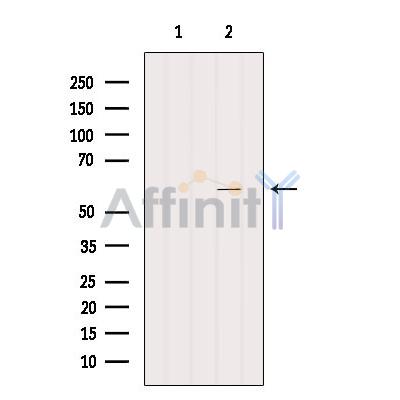UBAP1 Antibody - #DF12064
| Product: | UBAP1 Antibody |
| Catalog: | DF12064 |
| Description: | Rabbit polyclonal antibody to UBAP1 |
| Application: | WB IHC |
| Reactivity: | Human, Mouse, Rat, Monkey |
| Prediction: | Pig, Zebrafish, Bovine, Horse, Sheep, Rabbit, Chicken, Xenopus |
| Mol.Wt.: | 55 kDa; 55kD(Calculated). |
| Uniprot: | Q9NZ09 |
| RRID: | AB_2844869 |
Related Downloads
Protocols
Product Info
*The optimal dilutions should be determined by the end user. For optimal experimental results, antibody reuse is not recommended.
*Tips:
WB: For western blot detection of denatured protein samples. IHC: For immunohistochemical detection of paraffin sections (IHC-p) or frozen sections (IHC-f) of tissue samples. IF/ICC: For immunofluorescence detection of cell samples. ELISA(peptide): For ELISA detection of antigenic peptide.
Cite Format: Affinity Biosciences Cat# DF12064, RRID:AB_2844869.
Fold/Unfold
MGC8710; NAG20; Nasopharyngeal carcinoma associated gene 20 protein; UAP; UBAP 1; UBAP; Ubiquitin associated protein 1;
Immunogens
A synthesized peptide derived from human UBAP1, corresponding to a region within C-terminal amino acids.
Ubiquitous. Highly expressed in heart, brain, placenta, lung, liver, skeletal muscle and pancreas.
- Q9NZ09 UBAP1_HUMAN:
- Protein BLAST With
- NCBI/
- ExPASy/
- Uniprot
MASKKLGADFHGTFSYLDDVPFKTGDKFKTPAKVGLPIGFSLPDCLQVVREVQYDFSLEKKTIEWAEEIKKIEEAEREAECKIAEAEAKVNSKSGPEGDSKMSFSKTHSTATMPPPINPILASLQHNSILTPTRVSSSATKQKVLSPPHIKADFNLADFECEEDPFDNLELKTIDEKEELRNILVGTTGPIMAQLLDNNLPRGGSGSVLQDEEVLASLERATLDFKPLHKPNGFITLPQLGNCEKMSLSSKVSLPPIPAVSNIKSLSFPKLDSDDSNQKTAKLASTFHSTSCLRNGTFQNSLKPSTQSSASELNGHHTLGLSALNLDSGTEMPALTSSQMPSLSVLSVCTEESSPPNTGPTVTPPNFSVSQVPNMPSCPQAYSELQMLSPSERQCVETVVNMGYSYECVLRAMKKKGENIEQILDYLFAHGQLCEKGFDPLLVEEALEMHQCSEEKMMEFLQLMSKFKEMGFELKDIKEVLLLHNNDQDNALEDLMARAGAS
Predictions
Score>80(red) has high confidence and is suggested to be used for WB detection. *The prediction model is mainly based on the alignment of immunogen sequences, the results are for reference only, not as the basis of quality assurance.
High(score>80) Medium(80>score>50) Low(score<50) No confidence
Research Backgrounds
Component of the ESCRT-I complex, a regulator of vesicular trafficking process. Binds to ubiquitinated cargo proteins and is required for the sorting of endocytic ubiquitinated cargos into multivesicular bodies (MVBs). Plays a role in the proteasomal degradation of ubiquitinated cell-surface proteins, such as EGFR and BST2.
Cytoplasm>Cytosol. Endosome.
Note: Predominantly cytosolic (PubMed:21757351). Recruited to endosomes as part of the ESCRT-I complex (PubMed:21757351).
Ubiquitous. Highly expressed in heart, brain, placenta, lung, liver, skeletal muscle and pancreas.
The UMA domain mediates association with the ESCRT-I complex.
Restrictive clause
Affinity Biosciences tests all products strictly. Citations are provided as a resource for additional applications that have not been validated by Affinity Biosciences. Please choose the appropriate format for each application and consult Materials and Methods sections for additional details about the use of any product in these publications.
For Research Use Only.
Not for use in diagnostic or therapeutic procedures. Not for resale. Not for distribution without written consent. Affinity Biosciences will not be held responsible for patent infringement or other violations that may occur with the use of our products. Affinity Biosciences, Affinity Biosciences Logo and all other trademarks are the property of Affinity Biosciences LTD.



